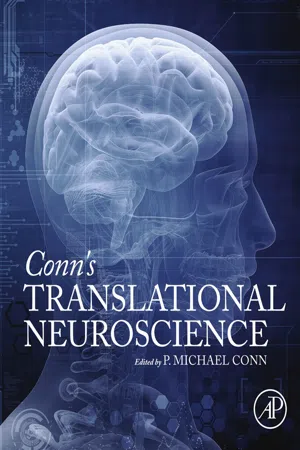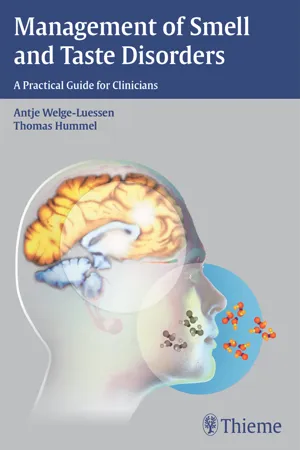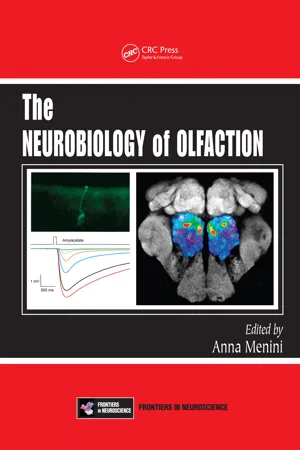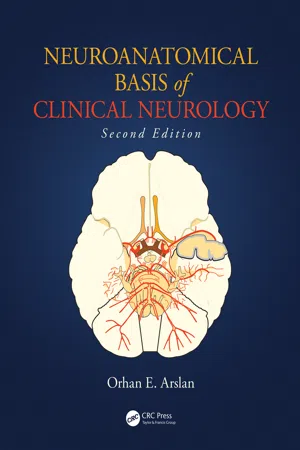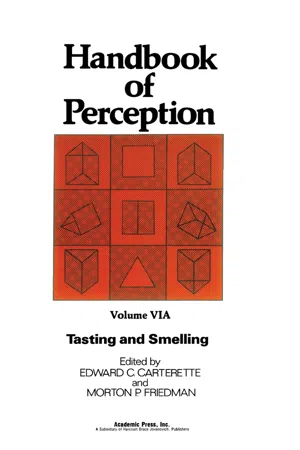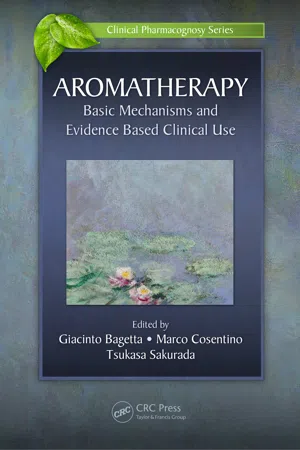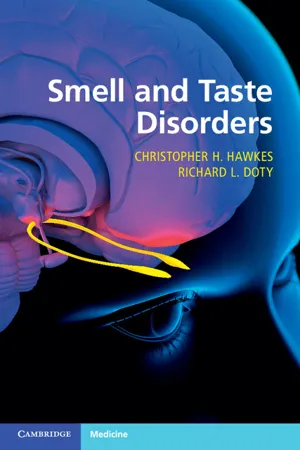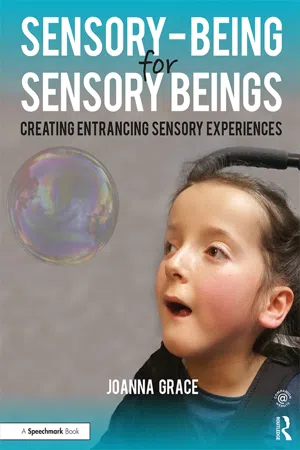Psychology
Olfactory System
The olfactory system is responsible for the sense of smell. It involves the detection of airborne chemical molecules by olfactory receptors in the nasal cavity, which then send signals to the brain for interpretation. The olfactory system plays a crucial role in detecting and identifying various scents, which can evoke strong emotional and memory responses.
Written by Perlego with AI-assistance
Related key terms
1 of 5
11 Key excerpts on "Olfactory System"
- eBook - ePub
- P. Michael Conn(Author)
- 2016(Publication Date)
- Academic Press(Publisher)
Chapter 17The Olfactory System
C. Trimmer1 , and J.D. Mainland1 , 21 Monell Chemical Senses Center, Philadelphia, PA, United States2 University of Pennsylvania School of Medicine, Philadelphia, PA, United StatesAbstract
Chemicals provide a rich source of information about the environment, and many animals trust their sense of smell with their most important tasks: finding prey, avoiding predators, identifying mates, marking territory, navigating their environment, recognizing kin, and establishing social hierarchies. How the Olfactory System detects and discriminates a vast number of odors, however, is poorly understood. The mammalian Olfactory System consists of a variety of subsystems distributed throughout the nasal cavity. In the periphery, a variety of receptor families detect chemicals in the environment and transduce them into neural signals. The majority of these signals pass first through the olfactory bulb where the odor is believed to be encoded as a spatiotemporal code. Higher brain areas may then pair different receptor-activation profiles into a single olfactory percept or associate the odor with nonolfactory information. Here, we examine how the Olfactory System carries out these tasks, as well as disorders that disrupt this encoding, resulting in olfactory dysfunction.Keywords
Neuroscience; Nose; Odor; Olfaction; Olfactory bulb; SensoryIntroduction
Defining the Olfactory System is not a straightforward task. Although humans tend to think of the Olfactory System as designed to detect volatile molecules and the gustatory system to detect nonvolatiles, the distinction between the two systems is based on anatomy rather than stimulus properties. In fish the Olfactory System detects molecules in solution, not in air, but fish maintain anatomically distinct olfactory and gustatory systems. The Olfactory System is not, however, a unified anatomical structure, but rather a collection of subsystems with distinct anatomy, receptor repertoires, transduction mechanisms, and central projections. All of these subsystems are united by their function: detecting chemicals in the environment and transducing them into neural signals. - Stephen F. Davis, William Buskist, Stephen F. Davis, William F. Buskist(Authors)
- 2007(Publication Date)
- SAGE Publications, Inc(Publisher)
The future direction of olfactory research is exciting; it should help our understanding of the more complex visual and audi-tory systems that may have evolved from it. It will make a unique contribution to the study of human consciousness. Finally, it has growing practical relevance to the study of human health and disease. Olfaction is not what you think. Although most of us know that we need eyes to see and ears to hear, most of us do not know that we need a nose to “taste,” yet olfaction is central to our enjoyment of eating and drinking. Indeed, most of us probably regard olfaction as nothing more than an occasional sniff of a flower or the heady whiff of garbage or somebody else’s unwashed body. But olfaction pervades our life in many ways, betraying whether we are likely to develop Alzheimer’s disease or schizophre-nia, and indeed, if some are to be believed, influencing whether others find us attractive, as well as allowing us to recover forgotten memories from childhood. However, as interesting as these things are, they are not the reasons that most psychologists choose to study smell. Rather, it is the beguiling mystery of how it works, a conundrum that is still not resolved and at the moment forms the central focus for many psychologists working in this field. This chapter starts by directly addressing this issue and, as you will see, the picture that emerges is indeed bizarre—what you smell is a memory. Olfaction • 217 THEORY Function In both humans and animals, the basic function of the Olfactory System is to detect and recognize biologically relevant chemicals (i.e., food, mates, kin, predators). This is no easy matter. The environment is full of chemicals that can be detected by the Olfactory System. In addition, nearly all odors—which we perceive as being discrete entities—are in fact combinations of 10s or 100s of dif-ferent volatile (i.e., smellable) chemicals.- Shiv Kumar, Noopur Gautam(Authors)
- 2023(Publication Date)
- Delve Publishing(Publisher)
Despite this, there is no denying the influence that smell has on behavior and cognition (Anton & Luciano, 2007). Multiple studies have found that there is a significant connection between the way people experience scent and the reactions it elicits in them. There are many facets of life in which olfactory cues play an important role, including dating, parenting, and feeding. The sense of smell may also play a role in cognitive processes, the regulation of mood, and emotional responses. Failure of the Olfactory System is directly linked to the development of severe disorders such as neuropsychiatric depression and difficulty with eating. As a consequence of this, the link between the two conditions has been established. Because of this, having a comprehensive knowledge of the molecular processes that are involved in olfaction is essential for comprehending animal behavior in both normal and abnormal circumstances. Olfactory sensory neuroepithelial cells are remarkable in that they send direct projections to the main olfactory bulb without the need for an intermediary brain region. These cells express odor receptors that are only found in the nasal cavity. The Molecular Organization of the Brain (MOB) is comprised of numerous cell types to process olfactory information and transmit it to higher brain regions. Sanchez -research Gonzalez investigated the geographical origins, heterogeneity, and genetic composition of the olfactory bulb interneurons to gain a better understanding of how they develop from various types of progenitor cells located throughout the brain. In his contribution to the research on the cytoarchitecture of the olfactory circuit, Fengyi Liang analyzes the significance of the cellular interaction that occurs between olfactory receptor neurons and olfactory sustentacular cells. Multiple olfactory processes are dependent on intricate cell-to-cell interactions, which are also controlled by the neuromodulatory systems.- No longer available |Learn more
- (Author)
- 2018(Publication Date)
- Wiley(Publisher)
Most humans mistrust their sense of smell as a fickle and imprecise system when compared with vision or audition. In stark contrast, most mammals rely upon it for many crucial tasks—identifying food, avoiding predators, and finding mates. Due to the human bias toward vision and audition, olfaction is, in many respects, a poorly understood sense. While we have electronic devices that can record and reproduce images and sounds, we have not developed devices that can do either reliably for odors. This is due to a number of issues, including the fact that odor space is vast and we have very little understanding of its inherent organization, as well as the fact that these molecules are sensed by a sprawling set of receptors. These features make the study of olfaction both challenging and rewarding. Recent discoveries in molecular biology and advances in optogenetics suggest that the tools may be at hand to decipher the olfactory code. These advances, however, require a solid grounding in human psychophysics. Indeed, compared to the study of vision and audition, the study of olfaction has an unusual trajectory. Research in the former modalities initially focused on human behavioral phenomena and then successively added work from electrophysiology as it came online, followed by molecular biology and genetics as these disciplines developed. In contrast, the Olfactory System defied many early attempts to organize the stimulus space and make sense of its neural properties. The central foothold came from the discovery of the olfactory receptor repertoire and the breathtaking organizational structure of the olfactory bulb that was revealed only through genetic constructs (Buck & Axel, 1991; Mombaerts et al., 1996). This led many to use the organization of the olfactory bulb input to infer systems‐level organization, but this is unlikely to lead to an understanding of odor coding without more human psychophysical data.This chapter begins by describing the olfactory stimulus and then moves to a discussion of the anatomy of the Olfactory System from the nasal cavity to the central nervous system. This structural description is followed by an examination of the basics of sensory processing, a description of standard methods for studying olfaction, and an overview of basic results from psychophysical analyses. The psychophysics of olfaction is followed by a review of olfaction in higher‐level cognition, and the chapter concludes by describing clinical dysfunction in olfaction. We will focus, when possible, on the main Olfactory System of humans, with some supporting data, largely from mammals.THE OLFACTORY STIMULUS
The mammalian Olfactory System detects volatile molecules in the environment. Molecules are combinations of atoms held together by chemical bonds, but given that there are over 100 types of atoms and many suitable rearrangements of these atoms, the number of possible molecules is enormous. Most of the molecules we smell, both in nature and created synthetically by chemists, are made from only five types of atoms: carbon, hydrogen, oxygen, nitrogen, and sulphur. Not surprisingly, these are also the most common molecules in organic chemistry. More rarely, an odor will contain chlorine, bromine, or iodine. Molecules with other atom types are capable of having an odor, but are rarely encountered in the natural environment. To narrow this chemical space down to odor space, we can also eliminate all molecules that cannot reach the olfactory receptors, which are located in the dorsal nasal cavity and bathed in an aqueous layer of mucus. Figure 4.1 - eBook - PDF
Management of Smell and Taste Disorders
A Practical Guide for Clinicians
- Antje Welge-Lüssen, Thomas Hummel(Authors)
- 2013(Publication Date)
- Thieme(Publisher)
(Adapted from Lundström et al. 2011. 33 ) 36 3 Functional Anatomy of the Olfactory System II: Central Relays, Pathways, and their Function tion all tertiary neocortical, diencephalic, and brainstem areas targeted by projections of the for-mer regions. One should wonder if, after sniffing a simple odor, the entire brain might be involved and occupied with processing this particular sensation. Certainly, it is not. An approach to determine the specialization of diverse olfactory-related brain areas was introduced by measuring the effects of task-specific stimulation. There are, for example, hemispheric differences in perception of familiar/ unfamiliar or pleasant/unpleasant stimuli. The left hemisphere is more engaged in processing familiar odors, and the right hemisphere in that of unpleas-ant odors. 57 Further, olfactory detection, discrimi-nation, and memory recovery from experience implies the hierarchical recruitment of different structural and functional relays within the olfac-tory system. 58 Lateralization As previously introduced, there is some evidence for olfactory lateralization (i.e., specific olfactory tasks are represented in one hemisphere). Olfac-tory nerve fibers project ipsilaterally up to the level of the pirC (see above). The anatomical sub-strate for lateralized cortical odorant processing seems to be the anterior part of the anterior com-missure, but proof of this possibility is still lacking. A recently published, event-related source imaging study provides evidence that olfactory informa-tion is processed in different steps, starting with ipsilateral activation of the amygdala, parahippo-campal gyrus, superior temporal gyrus, and insula. Subsequently, the corresponding contralateral structures are activated and, finally, frontal areas of both hemispheres are involved. 59 Accordingly, monorhinally presented odorants activate bilat-eral higher order brain areas independent of the side of presentation. - eBook - PDF
- Anna Menini(Author)
- 2009(Publication Date)
- CRC Press(Publisher)
The processing mechanisms of the human brain flavor system can therefore be viewed as one of our highest faculties in the struggle for survival during human evolution. From this and many other perspectives, smell perception and the human brain flavor system are the last frontiers of olfactory research. REFERENCES Adrian, E.D. 1953. Sensory messages and sensation; the response of the olfactory organ to different smells. Acta Physiol Scand 29 (1):5–14. Alvarez, P. and H. Eichenbaum. 2002. Representations of odors in the rat orbitofrontal cortex change during and after learning. Behav Neurosci 116 (3):421–33. Araneda, R.C., A.D. Kini, and S. Firestein. 2000. The molecular receptive range of an odorant receptor. Nat Neurosci 3 (12):1248–55. Arevian, A.C., V. Kapoor, and N.N. Urban. 2008. Activity-dependent gating of lateral inhibition in the mouse olfactory bulb. Nat Neurosci 11 (1):80–87. Attwell, D. and S.B. Laughlin. 2001. An energy budget for signaling in the grey matter of the brain. J Cereb Blood Flow Metab 21 (10):1133–45. Aungst, J.L., P.M. Heyward, A.C. Puche, S.V. Karnup, A. Hayar, G. Szabo, and M.T. Shipley. 2003. Centre-surround inhibition among olfactory bulb glomeruli. Nature 426 (6967):623–29. Buck, L. and R. Axel. 1991. A novel multigene family may encode odorant receptors: A molecular basis for odor recognition. Cell 65 (1):175–87. Chen, W.R. and G.M. Shepherd. 2006. The olfactory glomerulus: A cortical module with specific functions. J Neurocytol 34:353–60. Cleland, T.A., B.A. Johnson, M. Leon, and C. Linster. 2007. Relational representation in the Olfactory System. Proc Natl Acad Sci USA 104 (6):1953–58. Gietzen, D.W. and Q.R. Rogers. 2006. Nutritional homeostasis and indispensable amino acid sensing: A new solution to an old puzzle. Trends Neurosci 29 (2):91–99. Graziadei, P.P. and G.A. Monti Graziadei. 1985. Neurogenesis and plasticity of the olfactory sensory neurons. Ann N Y Acad Sci 457:127–42. Khan, R.M., C.H. Luk, A. - eBook - PDF
- Orhan E. Arslan(Author)
- 2014(Publication Date)
- CRC Press(Publisher)
377 Chemicals that dissolve in liquid stimulate both olfac-tory and taste receptors in a similar way. The perception of food flavor is dependent upon the close interaction between the olfactory and gustatory (taste) systems. The Olfactory System detects, recognizes, and finely discrimi-nate airborne odorants. This special visceral sensation becomes functional at birth and effectively operates even at low molecular concentration of the odorants. Odorants bind reversibly to the receptor membrane proteins in the olfactory epithelium, generating depolarization and action potentials through a series of interactions. Propagated action potentials converge on the olfactory bulb and course through the olfactory tract and the striae to the pyriform cortex. Association cortices also receive olfac-tory projection indirectly from the pyriform cortex via the thalamus. Olfaction is considered one of the oldest sys-tems that directly influences feeding behavior, emotion, social attitude, protective reaction, and sexual desire. This is achieved through extensive connections to diverse areas of the brain including the septal area, entorhinal cortex, and amygdala. Pheromones can elicit responses that affect the reproductive cycles, possibly through a hypothalamic connection; however, the precise mechanism that under-lies the processing of these chemosensory signals and the role of the vomeronasal organ (VNO) remain at best preliminary. PERIPHERAL OLFACTORY APPARATUS The olfactory apparatus consists of the sensory epithelium with supporting cells and chemoreceptor cells that detect and discriminate between different airborne odorants. Olfactory information is conveyed, in the form of electrical signals, via the olfactory nerves to the olfactory bulb and eventually via the olfactory tract and striae to the primary olfactory cortex. - eBook - PDF
- Edward C. Carterette(Author)
- 2012(Publication Date)
- Academic Press(Publisher)
The hypothalamus is separated from the olfactory periphery by only two synapses; a much more direct connection than that of any other sensory hypothalamic input. It is not surprising, therefore, that close relationships are found between olfactory sensation and reproductive behavior. Many important specific chemical messengers (pheromones) have been identified in diverse animal species. Lesions in the olfactory pathways have strong effects on reproductive behavior in particular, but also on many other functions. Above the level of the bulb, olfactory physiology rests squarely upon the work of the behaviorists. There is so little infor-mation about unit responses and evoked potentials to odorous stimulation that no synthesis is possible at present. The questions raised in the work on the olfactory periphery are challenging. The important conceptual and experimental work is yet to come. References Adrian, E. D. Sensory discrimination with some recent evidence from the olfactory organ. British Medical Bulletin, 1950, 6, 330-333. Adrian, E. D. Olfactory discrimination. L'Annee Psychologique, 1951, 50, 107-113. Allison, A. C , & Turner-Warwick, R. T. Quantitative observations on the Olfactory System of the rabbit. Brain, 1949, 72, 186-197. Altner, H., & Boeckh, J. Über das Reaktionsspectrum von Rezeptoren aus der Riechschleimhaut von Wasserfröschen. (Rana esculenta). Zeitschrift für vergleichende Physiologie, 1967, 55, 299-306. Amoore, J. E. Olfactory genetics and anosmia. In L. M. Beidler, (Ed.), Handbook of sensory physiology. IV: Chemical senses, Part 1, Olfaction. Heidelberg: Springer-Verlag, 1971. Pp. 245-256. Blank, D. L. Mechanism underlying the analysis of odorant quality at the level of the olfactory mucosa. II. Receptor selective sensitivity. Annals of the New York Academy of Sciences, 1974, 237, 91-101. Boeckh, J., Kaissling, K. E., & Schneider, D. Insect olfactory receptors. Cold Spring Harbor Symposia on Quantitative Biology 1965, 30, 263-280. - eBook - PDF
Aromatherapy
Basic Mechanisms and Evidence Based Clinical Use
- Giacinto Bagetta, Marco Cosentino, Tsukasa Sakurada, Giacinto Bagetta, Marco Cosentino, Tsukasa Sakurada(Authors)
- 2015(Publication Date)
- CRC Press(Publisher)
31 The Olfactory System 2.8.1 P ERCEPTUAL L EARNING Olfactory perceptual learning is the improvement through experience in the detec-tion or discrimination of olfactory stimuli. Studies in humans have shown that the repeated exposure to a given odorant could decrease its detection threshold (Dalton et al. 2002; Stevens and O’Connell 1995). Moreover, although many people cannot smell androstenone, they become sensitive to its smell after repeated exposures to this odorant (Mainland et al. 2002; Wysocki et al. 1989). 2.8.2 O LFACTORY O BJECTS Most odorants in the external environment are composed of a complex mixture of structurally different odorant molecules, but the Olfactory System is able to synthe-size these signals into a unitary perceptual object. In the natural context, a given odorant stimulus must be perceived in the presence of a variable background of several other odorants; therefore, the Olfactory System must be able to selectively fil-ter the information from the background while perceiving the relevant information. Moreover, an olfactory object does not have a constant composition of its odorant components, and the molecules reaching the olfactory epithelium may change for several reasons. For example, a rose may have some odorant components different from those of other roses, the presence of the wind may modify the flux of mol-ecules reaching the olfactory epithelium, or some molecules of the mixture may be degraded with time. However, the Olfactory System is often capable of perceiving the overall smell as that of a rose. The process of adaptation, occurring at several levels of the Olfactory System, plays an important role for the identification of an olfactory object in the presence of other odorants, as it produces a decrease of the response to background odorants, allowing the detection of other stimuli. Several studies have addressed the issue of how the Olfactory System may produce the synthetic representation of an olfactory object. - eBook - PDF
- Christopher H. Hawkes, Richard L. Doty(Authors)
- 2018(Publication Date)
- Cambridge University Press(Publisher)
Most olfactory receptors are “generalists,” responding to a range of chemical moieties. Even single-molecule odorants, which are the exception rather than the rule, are agonists for multiple receptors, indicating that the “code” for a given odorant sensation reflects a patterned combination of neural Anatomy and Physiology of Olfaction 37 activity across different receptor types. The olfactory bulb, the first olfactory relay station in the brain, sharpens and refines the incoming signals from multiple molecules, aiding the ultimate synthesis of information from numerous peripheral inputs into single odor “percepts.” Cortical regions receiving projections from the olfactory bulb include those collectively termed the “primary olfactory cortex”; namely, the anterior olfactory nucleus, piriform and peri-amygdaloid cortices, entorhinal cortex, olfactory tubercle, and corti- comedial nuclear group of the amygdala. Reciprocal relationships exist among these brain regions, as well as many other brain regions. The piriform cortex is no longer viewed as a simple relay station, but, along with the amygdala, responds to odor intensity, valence, and memory. Multiple factors influence the ability to smell, including age, gender, cigarette smoking, environmental pollution, and circulating levels of reproductive hor- mones. Some individuals, for all practical purposes, cannot detect certain odorants, a problem termed “specific anosmia.” Preferences for odors are influenced by a number of experiential factors, including cultural experiences with odors. Many disorders alter smell function, as described in detail in Chapters 5 and 7. In Chapter 3 we describe practical clinical means for quantifying smell function to help formulate a prognosis and monitor treatment efficacy. References Adrian, E.D., 1942. Olfactory reactions in the brain of the hedgehog. Journal of Physiology 100, 459–473. Amoore, J.E., 1967. Specific anosmia: A clue to the olfactory code. Nature 214, 1095–1098. - eBook - PDF
Sensory-Being for Sensory Beings
Creating Entrancing Sensory Experiences
- Joanna Grace(Author)
- 2017(Publication Date)
- Routledge(Publisher)
48 4 Stimuli for the olfactory sense This chapter begins with an examination of the value of our olfactory sense and a consideration of how many sensory systems we have. In Part B, we look at how our olfactory sense develops and what experiences are likely to appeal to Sensory Beings as they begin their adventures with smell. In Part C, we continue to explore olfactory experiences likely to interest Sen-sory Beings and how to facilitate these for maximal benefit as we consider how we take in and process the smells in our environment. Part A: the olfactory sense; one of many fascinating senses Our olfactory sense of smell is an undervalued sense. Often, we do not realise what it brought to our lives until it is gone. In Part A, we look at the role our olfactory sense plays in our lives over and above the obvious one of telling us what things smell like. This leads us to an interesting tangent in the second part of Part A, as we consider how many senses we truly have: is it 5, is it 7, 9, 11, or even 33? Like all senses, smell has a development. But, because it is not a sense we value as highly as some, we are not so prone to thinking of it as a linear sequence of achievements. You may have overheard a parent proudly declaring their child can identify certain colours. Have you ever overheard a parent declaring what scents their child can identify? Survival value Historically our sense of smell would have been a valuable tool for keeping us safe: we would have smelt out food to eat; we would have sniffed food to check whether it was off; we would have smelt sickness in others and avoided them. Today, if you put a dish of food down before me in a restaurant that smelt a bit funny, I would be just as likely to override my instincts and assume the scent was the chef’s intention as to send it back to the kitchen. 49 Stimuli for the olfactory sense Smell would also have played a role in how we chose a mate.
Index pages curate the most relevant extracts from our library of academic textbooks. They’ve been created using an in-house natural language model (NLM), each adding context and meaning to key research topics.
